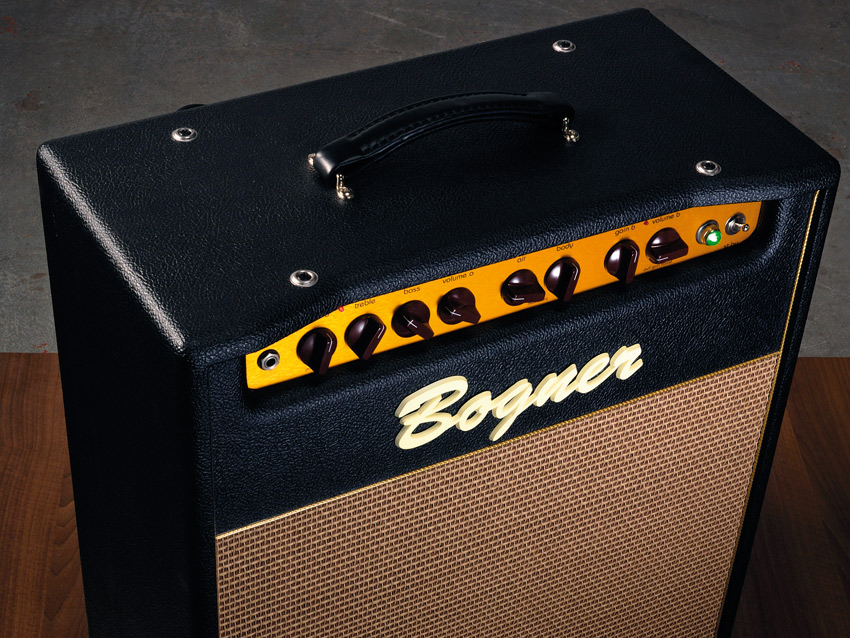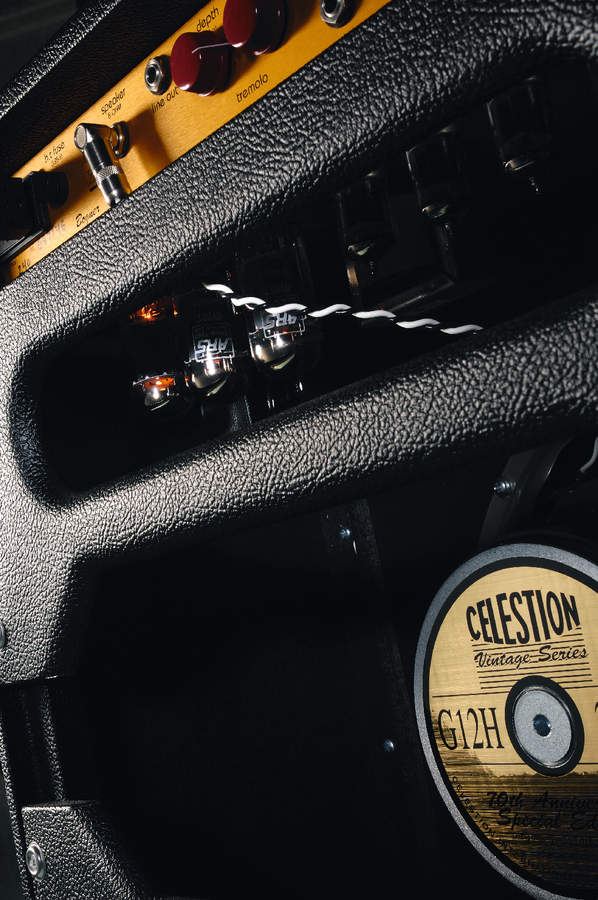MusicRadar Verdict
We may have a couple of minor quibbles but it´s the sound that gets you - and isn´t that the most important thing?
Pros
- +
Overall top notch build and design. Highly addictive, easily accessed sounds from clean to high gain.
Cons
- -
Single speaker output. No impedance switch. Fiddly footswitch lead. Not the cheapest.
MusicRadar's got your back


Small but perfectly formed, the Duende is a very portable 1 x 12 combo, though there's enough weight on that single carry handle to remind you it's not your average practice amp.
Bogners are always sharply styled and the Duende is no exception - the cabinet is assembled and finished to a very high standard with neat vinyl work, especially on the rear panel cut-outs.
The aluminium chassis is typical Bogner, covered inside and out in a rich gold-anodised finish which co-ordinates nicely with the dark red 'gas cooker' knobs on the front panel and the tough straw-coloured speaker grille.
Inside the chassis, most of the Duende's components are held on a large main PCB, with two smaller boards for the rear panel stuff and the primary mains protection that all Bogners feature. The main PCB's layout indicates the preamp valve sockets may have been originally intended to be directly soldered to it, however they're bolted to the chassis and connected by short flying leads, as are the power valves and the front panel controls for reliability and easy servicing.
"This is a great little amp that will inspire even the most jaded of 'seen it all before' guitarists to plug in and play for hours."
The Duende is a proper two-channel design, with some typical Bogner twists: channel A is a low-gain affair intended for clean rhythm through to mild crunch distortion and features gain, treble, bass and volume controls, with a pull bright switch on the gain knob.
Channel B has just two controls - gain and volume - with a lot more gain on tap and a pull boost on the volume knob. Then there's a master EQ which affects both channels, with two knobs labelled 'air' and 'body' governing overall treble and bass response, so Channel B isn't completely EQ-less.
There's a spring reverb with separate level controls for each channel, and a built-in tremolo with controls for speed and depth. You can use either channel on its own or both at the same time - this is done either through the supplied three-button footswitch, which also toggles the tremolo effect, or from a handy rotary switch on the rear panel.
The tremolo can also be toggled on or off from a switch on the depth control, so unlike some amps, you aren't reliant on a footswitch to access all the functions. The Duende's rear panel also includes a simple series effects loop and a handy line out socket - though sadly there's only one speaker jack and no means of switching impedance. The mains socket neatly incorporates the mains switch - the single toggle on the front panel is a standby, letting you mute the amp while keeping it powered up.
In use
Perhaps one easy way to understand what this amp can do is to think of it as the ultimate supercharged tweed Deluxe. Channel A's gain range is perfectly judged and takes our standard Strat's single-coil pickups from punchy clean, through a very addictive chime effect to a mild, touch-sensitive distortion with the gain control at maximum - great for chilling blues solos.
The Duende's basic character is fat and warm, though there's plenty of EQ range to add bite or increased depth where needed, both aided by Bogner's clever choice of a Celestion G12H30 for this combo. This speaker has exactly the right resonant peak to complement the 6V6 output stage and a sweet top end that's not overly bright.
But enough of the subtle stuff, you wanna burn and Channel B is where you'll find all the lead gratification you'd hope for from an amp that has the Bogner logo on it. Unboosted it is perfect for the more aggressive modern blues stuff, with more of that spongy touch-sensitive valve-rectified response, and you can simply pull out the boost if you need extra sustain for the ballad solo.
Very tweed and very Deluxe in character, very responsive and a delight to play from the second you plug into it, the Duende had us hooked with its great tone and friendly response. Swap to humbuckers, and from Royal Scam-era Larry Carlton to Billy Gibbons or David Grissom, the Duende can get you exactly the right tone for practically all those rhythm and solo parts.
Carlton teamed his one-of-a-kind Gibson ES-335 with a tweed Fender Deluxe for most of his studio career, and with both channels cooking simultaneously - whether you can wrap your fingers around Kid Charlemagne and Don't Take Me Alive or not - all the right vocal nuances are there with this amp.
Wind the gains up, and you can also rip into Sharp Dressed Man or Jesus Just Left Chicago with total authenticity - assuming you have a '59 Les Paul and Billy Gibbons' fingers, that is!
Despite its relatively low output, the Duende is plenty loud enough for smaller un-mic'd gigs, yet still sounds cranked at low volume levels, making it ideal for home use or recording. The reverb is excellent, not too bright or crashy, with very little noise and a nice smooth decay.
The tremolo is annoyingly almost perfect - the range of speed and depth is exactly wide enough to cater for every need without going over the top, however we think the modulation waveform is just a little too smooth to catch that fashionable fast stuttering effect properly. If the Duende had a pull switch on the other tremolo knob to swap between normal and a harder-edged square-wave effect, it'd be practically perfect.
This is a great little amp that will inspire even the most jaded of 'seen it all before' guitarists to plug in and play for hours. It's portable, it sounds great at low volume, terrifyingly awesome when cranked and it's got nearly everything most players could ask for in the way of features.
However, the few niggles we have are annoying ones, more so because the Duende is nearly perfect. One output socket and no impedance selector makes it difficult to hook up to more speakers, which for live work could cut into the all-important clean headroom that gives this amp some of its subtlety and character.
The dual jack-plug footswitch cable is fiddly, though easier to repair in the field than an obscure seven-pin locking mini-DIN plug. It's purely a matter of taste, but we think the tremolo modulation needs a slightly sharper edge.
And, sadly, like all things that are good for you it is expensive. With a price tag of well over a hundred quid per watt, you'd expect mind-blowing performance, and by and large, the Duende delivers it, although so do many other amps at this level.
Nevertheless, the Duende is so tempting, that after five minutes you'll probably be thinking of how to justify buying one, so our advice is keep a tight grip on your wallet and check out this one soon at your nearest Bogner dealer.
MusicRadar is the number 1 website for music makers of all kinds, be they guitarists, drummers, keyboard players, djs or producers...
GEAR: We help musicians find the best gear with top-ranking gear round-ups and high- quality, authoritative reviews by a wide team of highly experienced experts.
TIPS: We also provide tuition, from bite-sized tips to advanced work-outs and guidance from recognised musicians and stars.
STARS: We talk to musicians and stars about their creative processes, and the nuts and bolts of their gear and technique. We give fans an insight into the actual craft of music making that no other music website can.
“I have an original 909 – every time I try to use it I feel like I’m ruining it”: House hero Riva Starr on his studio essentials and his love of analogue synths
“A synthesizer that is both easy to use and fun to play whilst maintaining a decent degree of programming depth and flexibility”: PWM Mantis review
“I feel like that song had everything we needed to come back with”: Bring Me The Horizon’s Lee Malia on Shadow Moses, its riff and the secrets behind its tone, and why it was the right anthem at the right time










